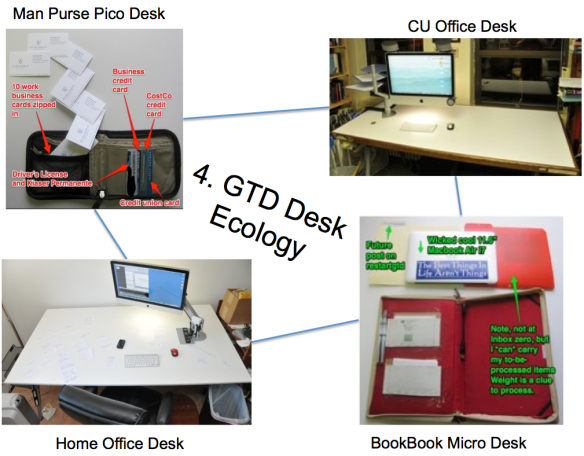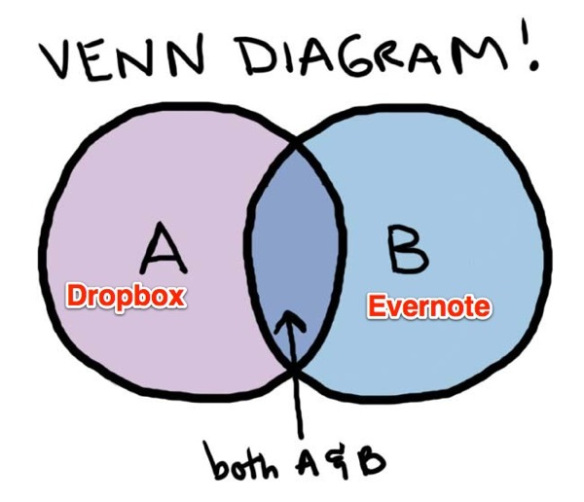- Where this blog came from:
- GTD: My Start, before and after GTD story, Time Lapse - 5 years of GTD
- Getting Started
- Restarting
- GTD Technology
- Desks
- The Perfect Desk Version 1, Version 2, Version 3, Version 4
- No money down desk
Category Archives: DropBox
Dropbox … I’ve gotta go back …
As I was constructing the GTD Time-Lapse post I mentioned in passing that Google Drive is not as reliable as Dropbox.
After I finished the post I went back and looked at Google Drive more carefully. In the beginning was Dropbox and everything was great except that I could not (then) put a file up and have many people download it.
I switched to Google Drive when I bought a Chromebook and drank the Google Apps Kool Aid. But, take a look at my experience with Google Drive:
Note that my Google Drive is named “Google Drive 2” … why? Great question!
Because, Google Drive sent me a “You Must Re Download you serfer of Google Apps” message. I renamed my original Google Drive “Old Google Drive” and then re-downloaded to “Google Drive 2” and didn’t think much of it.
Good thing I saved Old Google Drive … or maybe not. Here are two folders that exist in both Google Drive 2, and Old Google Drive:
In Google Drive 2 the pictures I was looking for are in the (1) folders. In Old Google Drive, they are in the folders without (1) after them. Fun?
Here is where I could taunt about which techie team has the MIT folks:
(a) Dropbox which performs flawlessly
(b) Google Drive which hiccups
But I won’t. :-)
Starting tonight, I’m migrating my digital stuff back to Dropbox.
bill
p.s., Unfortunately, RestartGTD is an unsponsored blog. Nobody compensated me to write this, with the possible exception of Amazon where you can buy that Fujitsu ScanSnap iX500 scanner that you’ve been waiting too long to pull the trigger on.
/* Fun Story*/
I paid to go to the David Allen seminar in Portland in November 2011. It was a great experience. Lots of chances to see what works for people to “get” GTD, and I figured out that I likely am a GTD black belt. This happened as a result of the leader asking “What have you all done to implement GTD?” And when everyone else was done, I told my story of using my Fujitsu ScanSnap to go paperless in 4 afternoons. At the next break, there were 10 people around me asking “What was that scanner you mentioned.” Lots of people want to be paperless, but if you don’t buy the infrastructure, you won’t be able to do it. See the post on GET OFF THE PAPERLESS FENCE only buy the newer ScanSnap (link above in the p.s. of this post).
GTD Time-Lapse
In the beginning, I was disorganized, no GTD, no Evernote, no OmniFocus, no Dropbox, no OneNote. My desk looked like this:
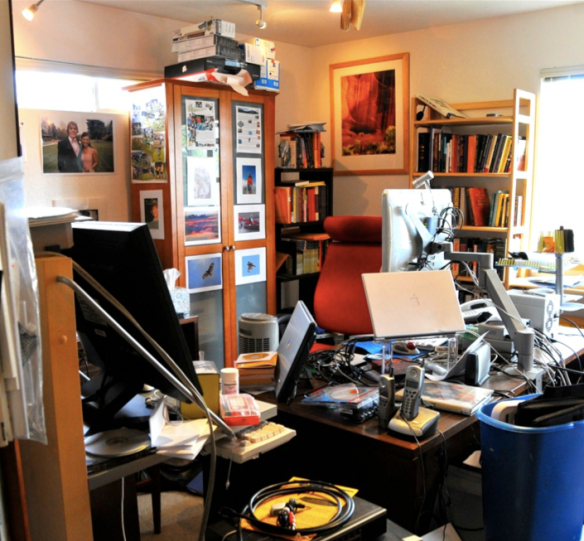
Then I went from no GTD to GTD via Paper and Evernote:
My desk changed to this:
Then, I got really excited, and went to a 100% digital GTD system via Omnifocus:
This is the first time I fell off the GTD wagon. I could not stand to sit down at my desk. The feeling of drowning by binary proxy kept me out of my organized office and away from my organized desk. Ugh! But the seeds of RestartGTD.com were born. Somewhere I’m POSITIVE I heard (via Audible copies of his books) David Allen say “If you get too organized, your brain will refuse to use your system.”
I refactored, cut back the role of Omnifocus, got a new job, Evernoted/digitized the 94,000 pages of notes I had from my Ph.D. and went to a hybrid paper and digital system that looked like this:
And my four desks looked like this:
Then as I experimented with my system and changed jobs I :
- Dropped Dropbox for Google drive when I bought a ChromeBook. Google drive is not even in the same league as Dropbox as far as reliability goes, but I’ve stayed with Google drive and Google Apps for simplicity’s sake.
- Added OneNote to keep work notes separate from home notes. This has actually facilitated manila folders as OneNote makes it *trivial* to print all my tabs (virtual manila folders) and put them into real labeled GTD manila folders.
- Kept 3×5 cards. They are indispensable for organizing. Laying a large number of cards out on a big table, then re-arranging them into thematic clumps, is the most powerful project organization tool that I possess. *Note* to OneNote and Evernote folks, please please please add 3×5 cards and a flexible user interface for re-arranging cards to your programs!!!!!
- Kept manila folders. In my new job, I can see my boss relax when I pull out a folder that has an updated project plan in it. And once she saw that she could look in one place for my project list and see what is going on, again, I could visibly see her relax.
- Kept eMail.
So my system now looks like this:
And my dungeon desk looks like this:
Thoughts on Tools:
- OmniFocus is an awesome tool. If you are going to implement GTD to the letter, I don’t think there is a better software package. But I learned that implementing GTD to the letter is not for my brain. But there is TREMENDOUS power in OmniFocus if it is for you.
- Evernote has been with me since the beginning of my GTD journey. I remember listening to David Allen say “the lack of a good general-reference system can be one of the greatest obstacles to implementing a personal management system” (p. 95 Kindle L1500) and realizing “Evernote! I can use Evernote to be my reference filing system!” You see I had Evernote before I read GTD, I just did not have a use model for it, because I did not appreciate how critical reference filing is to GTD.
- Evernote keeps adding tools. Some of them are wonky (Evernote Hello for example), but Web Clipper, Clearly, and Skitch have been game changers for me. Evernote has also gradually increased the kinds of files that it indexes (Word for example was a pain before Evernote started indexing it), and the handwriting recognition is slowly improving. The growth of Evernote’s tool set has kept me loyal as I know I don’t need to jump ship for the latest slick tool. Probably, this reticence kept me for too long from trying OneNote again. I was on the beta team for OneNote 1.0 and getting a change made to the program was like trying to teach a pig to sing.
- Dropbox is also an awesome tool. But it was (a) too expensive and (b) to focused on single users, at the time I adopted it. Dropbox too is adding tools, but unlike Evernote, Dropbox has not added tools at the point of most intense need for me, and built out from there. I’m sure to Dropbox, Evernote’s file replication must look plebeian, a pale copy of Dropbox with a different user interface. But to me, Dropbox is infrastructure first, and OneNote and Evernote are tools first, with backing infrastructure.
- OneNote has surprised me. The community of kindred minds around OneNote is much larger than Evernote. And OneNote has the same wonderful enthusiasm of Apple products and Evernote, among its users. OneNote has many of the same over-structured limits as Evernote, only 1 level of sub folders, for example. But, the user interface and the integration with Microsoft Office are freeing to my mind. And, I can’t wait to investigate OneNote add-ins. Evernote’s add-ins are a pallid picture of the promise of its API. More on OneNote as I delve deeper.
- Google Apps and Google Drive have converted me. I’m now keeping my evolving documents (like resume) on Google drive. I’ve had to delete and re-download my stored files three times. And when I look into my Google Drive folders now, I’m often missing files, finding renamed folders that indicate Google Drive has a problem with becoming confused. Dropbox has none of these issues. So I do miss being able to have confidence in my cloud storage. But I’m careful, back up A LOT, and limp through.
- Google Now. Another fun surprise. Google now reads my emails and then puts notifications on my phone and in my web browser automatically. This is a huge help for my absent mindedness (call me “Dr. Spaz” please).
Where GTDers are on our own.
David Allen does not recommend technology. Technology is too fad-y I suspect. So we are on our own in sharing experiences and frustrations. And, in dealign with providers like Evernote and MicroSoft and OmniGroup in advocating for GTD-helpful features.
GTDers are also on our own figuring out how to separate work and personal trusted systems. “When you’re trying to make a living there ain’t no such thing as pride.” Richard Marx - Don’t Mean Nothing Lyrics | MetroLyrics. And when you are in the middle or the bottom of a big company, keeping separate personal and work trusted system is a key survival skill.
GTD Toasters
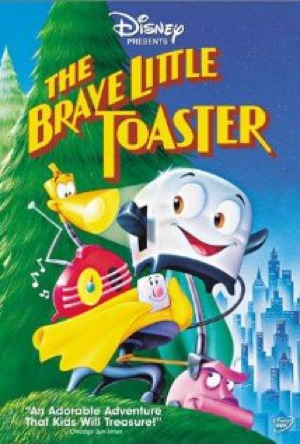
Source: IMDB
Introduction:
Here is a current picture of my GTD technology:
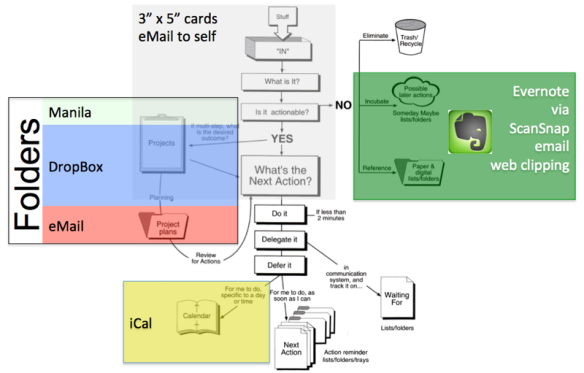
The biggest infrastructure changes from my reading of GTD are #1: Getting a killer reference filing system (see Evernote above), and #2: Using folders much much much much more than ever before (see Folders above).
Roughly four pieces of my trusted system are currently electronic, iCal, Evernote, DropBox and eMail.
GTD Toasters
Purpose of this post is to make GTDers aware of Synology NASes and that within Synology’s capability to deliver an IT department in a toaster sized box, are several GTD capabilities that may:
a. reduce unease,
b. save money, and
c. improve productivity.
Below is a picture of my now obsolete DS508 NAS. But, even though this NAS has not been sold for 5 years, over those 5 years, the DS508 gained a ton of GTD-relevant capabilities.
Synology DS508, An Oldie, but a Goodie!
The back story on my love of Synology products begins with a review. A review I wrote about Synology’s first NAS product in/for SmallNetBuilder.com in 2006. I had never heard of Synology before. But, having worked with firmware enginerds at HP I knew how great firmware *feels* when you use it. The buttery smooth operation, the impossibility of crashing, the inclusion features I needed, but didn’t know I needed. While reviewing the product, I emailed Synology’s president and said “This firmware is too good for a first product. What is the story with that?”
The president emailed back the explanation that Synology’s NAS was not its first product. Before developing NASes Synology had developed RAID software for enterprise storage systems. Read that sentence again, before building its NAS, Synology took on the most difficult software task in the world, for the noisiest pickiest customers in the world. Compared to enterprise difficulties, a home NAS was nothing.
But beyond providing basics, Synology from their first product has gone deeper than what customers say they want, to understanding customer needs and providing for them. As Guy Kawasaki would say Synology’s products have always been deep, indulgent, complete, and elegant (DICE).
For example, the Synology NAS I reviewed was the first NAS company to allow its customers to start a large download on a laptop, hand the download from laptop to NAS, so users can run to a meetings … with their laptops. *Note* No customers asked for this function. Synology has a strong connection with users so that it can be “lawyers” for the users in product design.
In the six years since, the only thing that has changed is that functionality going into Synology NASes, has accelerated.
a. Reduce Unease:
Synology NAS reduce unease by:
- Giving me “free” IMAP email that is not hosted by Apple or Gmail
- Giving me “free” unlimited cloud storage like DropBox but not hosted by DropBox
I’m re-reading THE SEARCH and in chapter 1 John Battelle reviews the big reasons to be uncomfortable with online services: surveillance, concentrations of data drawing hackers, not knowing how the service provider is using your data, the potential from being locked out of using your data. Having my email moved off free IMAP servers and on my NAS is a relief. Same for files on DropBox.
For those paranoid GTDers worried about having data on the internet, there is a key difference when you own the NAS and you can turn the sync service off except when you need to sync up your remote computers. DropBox does not allow you to turn off internet access to your data, Synology NASes do.
b. Save Money:
Synology NASes are not free. But, I justified buying a RAID5 NAS just based on protecting my digital photo library. Hosting email and project folders while not free, is no *incremental* cost. Synology also provides NAS anti-virus (also no *incremental* cost), remote access from anywhere on the net. Once you buy the NAS, there are no more incremental costs.
c. Increase productivity
Here is a picture of my next step GTD system.
I’ll still be using 3×5 cards and manila folders, but my Synology NAS allows me to migrate DropBox, eMail, and iCal. How does having my electronic “stuff” on my own NAS improve productivity? Great question!
- First, by silencing worries about my data’s safety. Data safety is the open loop none of us can ever be rid of. But, at some point, worry becomes paranoia. Having my data on a local NAS gives me more anonymity, some amount of security (Linux’s capabilities combined with the genius programmers at Synology), and allows me to silence data safety paranoia.
- Second, by increasing data mobility. When you have a NAS local with gigabit ethernet, you can download big files and take them with you to work on. DropBox and Evernote are big data lakes at the end of very narrow data straws. Even though both sync quickly, I often need to move a big file (data set or video I’m editing) before synchronizing completes. You may have different needs.
- Third, by giving me more degrees of freedom. Remember when PCs were new (I bought my first dual floppy IBM PC for $5K, it had 256K of RAM)? They were slower than the mainframe. They were less well backed up or maintained. But there was JUST SOMETHING about the PC that made it a magnet for end users. That something was degrees of freedom. Freedom to explore. Freedom to experiment. Freedom to organize work in new ways. Degrees of freedom are what made Napoleon, Napoleon. As Napoleon was the first battlefield commander to harness literacy. Instead of Napoleon staying up 24×7, pages that came in to headquarters reported to secretaries, who filed their reports in a file cabinet. This allowed Napoleon to sleep, that is, to retain all his IQ points while processing information from the battle. Seems like a little thing, but how we can record, store, and share information, underpins the architecture of how we work.
On Evernote:
Being a 6 year customer of Synology, I’m hoping that Synology will smell opportunity and build an program for NASes that does what Evernote does. If Synology could have DropBox and Evernote capabilities merged into one server, that would be sweet.
Have you heard about Amazon’s new “Whispersync for Voice” service? This allows your Kindle Fire HD to “human read” if you buy a Kindle book with Whispersync for Voice. Or, if you own both the Audible and Kindle versions of the book. Amazon owns Audible, Amazon owns Kindle, now they are tapping the Audible/Kindle interaction.
If Synology keeps on pushing NAS capabilities outside the box, watch out!
Hope this helps!
bill meade
Evernote VS DropBox a GTD Perspective
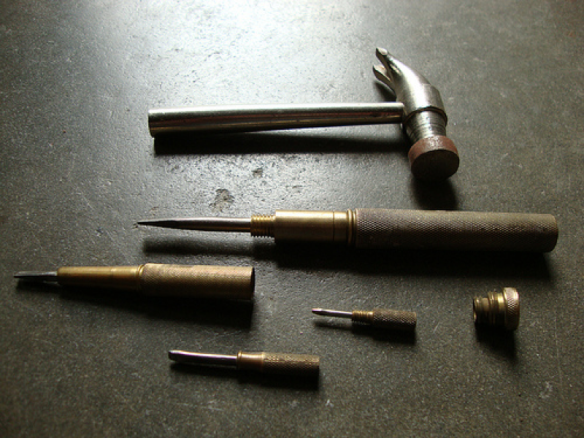
Source: Flickr.com
Introduction:
“Which should I use, Evernote or Dropbox?”
This is a frequent question for me. Which you should use, or whether you need to use both, is a question of degrees of freedom that you need to do your work efficiently AND effectively.
What is a degree of freedom?
I learned about degrees of freedom as a 20 something college graduate who was discovering computers for the first time. I had a friend, Glen Kuhn who was teaching me about mainframe computers, at the same time as the Bell+Howell division I was working in was flailing unsuccessfully with microcomputers.
About a month into learning about mainframes, I asked “Which is better, a microcomputer, a mini computer, or a mainframe.” To which Glen replied, “That all depends on what kind of power your need. Do you need rotational power? Or, do you need something else.” I had that “I recognize this is an interesting analytical distinction feeling,” at the same time as my brain hurt from trying to understand what a degree of freedom was.
Trying to understand degrees of freedom stayed with me until several years later in graduate school, I discovered M.J. French’s LUMINOUS book Invention and Evolution.
French’s illustration from page 95 brings the idea of a degree of freedom into sharp focus:
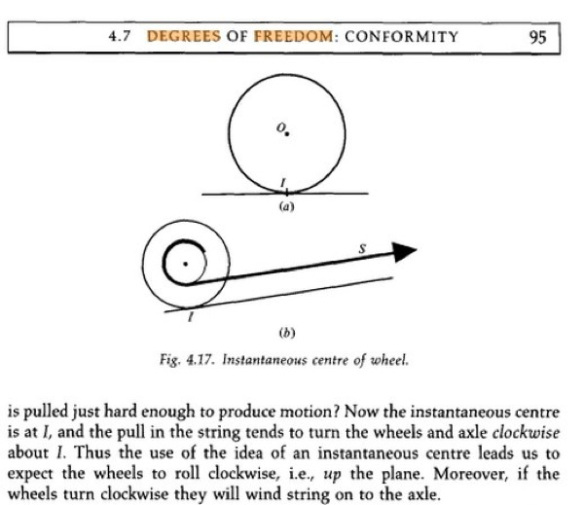
Source: Invention and Evolution, p. 95
A degree of freedom may seem simple from the outside, but they are not. Degrees of freedom are often counter intuitive, like pulling the string on part (b) of the above diagram causing the wheel to roll up the incline and wind string on to the axle.
But it gets better!!!!
Source: Flickr
Degrees of freedom also “nest” in sequences like Matryoshka dolls.
Another M.J. French explanation of this idea is the human arm. The shoulder is a ball joint and has 3 degrees of freedom. The elbow is two degrees of freedom (one bend to allow wrist to move from straight arm back to chest, a second that allows a twist so that the hand can turn things over). This gives 5 degrees of freedom. The wrist can bend back and forward, and also in a fly-casting motion, which brings us to 7 degrees of freedom. The fingers can bend down and back, and also sideways to spread the hand wide (2 DOF x 5 fingers = 10). So we are at 17 degrees of freedom to the knuckles. Then the fingers + 8 2nd and 3rd knuckles within the fingers. This brings us to 25 degrees of freedom. The general pattern in animals is to have a 3 degree of freedom joint, at the body, then a two, and then 1 degree of freedom joints as the limb travels away from the body (see French p. 98-100)
So what?
Well, degrees of freedom like the human arm has, are important because they allow the arm to do work. The nesting of 3-2-1 degrees of freedom is what gives humans the potential for great manipulative skill.
So what’s the connection to GTD?
The connection to GTD is that trusted systems also have nested degrees of freedom.
Source: Flickr
In fact, the nesting order of degrees of freedom are a large part of why GTD is a continuous improvement discipline. We can’t really simulate in our minds the best set of tools, the best nesting order of the tools. We can’t think our way to the globally optimal GTD system for ourselves.
So, we prototype, we test, we exploit serendipity, and over time we stumble towards greater efficiency and effectiveness using the GTD architecture. When David Allen says “the tools don’t matter” what I hear him saying is that “the lower degree of freedom tools don’t matter as longs as you’ve got the higher degree of freedom tools I teach, working well.”
Give me an example!
Ok, when I read GTD I keep getting hit by the root-level many-degree-of-freedom tools. For example:
- Next actions. Distilling the nub of what needs to happen, is like a 3 degree of freedom joint. We can then stuff next actions into our two degree of freedom manila folders or OmniFocus databases, or Evernote. Whatever. Next actions are high degree of freedom architectural features that allow us manipulative skill to make our days efficient and effective.
- Reference filing. Getting your paper stuff into Evernote, is also like a three degree of freedom joint. Once you have your reference archive in an easily searchable form, you discover: (a) that you can find ANYTHING in 60 seconds, and (b) that organizing stuff is a waste of time. Google is right, don’t organize, search!
- Project filing. Distilling what projects you are working on down to a file (manilla or electronic) is a high degree of freedom intervention. If you are lucky to be mentored by a GTD black belt as I was with Ian Watson, s/he will tell you “keep your project files separate from your reference files.”
- One idea one piece of paper. Perhaps the most important degree of freedom-providing intervention for me. One idea, one piece of paper gives your thoughts modularity. Allows them to go to the correct project, or to multiple projects. Allows you not to forget them over time. And allows your conscious and subconscious to collaborate in chewing over an idea.
- Weekly review. Again, like the idea modularity of one idea, one piece of paper, weekly reviews provide your work a lot of degrees of freedom. Refreshing on your projects replaces trying to predict (impossible) what the real deadlines are. Refreshing prevents worry. Refreshing allows sleep. Refreshing allows calmness when you are overloaded with work.
What does this have to do with Dropbox and/or Evernote?
Everything! Think of Dropbox as a screwdriver, and Evernote as a hammer. Now everyone knows that you can use a screwdriver as a crude form of hammer. Not a great hammer, the degrees of freedom of a screwdriver are too different from a hammer for it to work very well. And the same is true with hammers working as screwdrivers. You could probably remove some screws with the point of a claw hammer. But, it is probably better to go and get a screwdriver.
Now the key question: Would your rather use a screwdriver, or … a hammer?
**TILT**
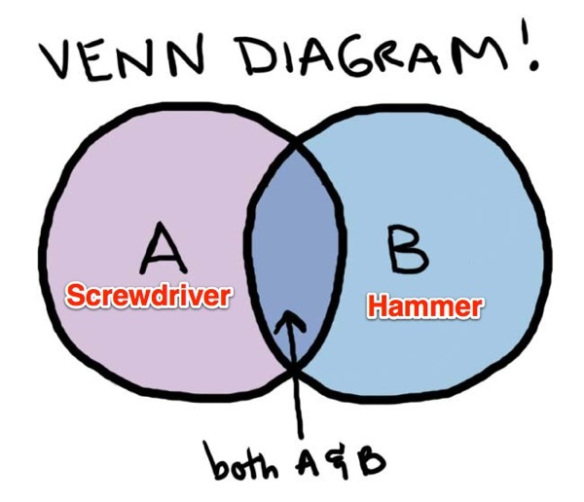
Source: After EK&FamilyBookReview
Of course, we instinctively know that we need both tools in our toolbox. Why? Because they have complementary degrees of freedom! We also need pliers in the tool box, and and power tools (which tend to be lower degrees of freedom than manual tools).
So what?
Well, the “should I use Dropbox or Evernote” question boils down to “What degrees of freedom do you need to support your GTD work?” And to the end of helping you figure this out, I’ve made a personal assessment of the degrees of freedom of Dropbox and Evernote and entered the data in the table below.
Source: billmeade please email [email protected] with corrections, comments, and additions!
Excel source here.
Source: After EK&FamilyBookReview
BUT … BUT …?
I suspect for most GTDers, the answer will be “choose both.” I’ve had a pro subscription to Evernote for 4 years. Evernote actually predates my walk with GTD. And, I’m skating along with DropBox’s free account. I’ve recommended DropBox with affiliate links so many times that I’ve got just short of 20 GB. So, I’m working to keep only active project files on DropBox to avoid spending money.
Which service to start with, to push GTD forward fastest?
I’m a fanboy of both, but I’m more of a fanboy for Evernote when I get this question. As I have stated repeatedly, I think Evernote is the GTD tool that will pull you back on the GTD wagon when you fall of. If you can just get the first 500 pages scanned into Evernote (12.5 minutes with a ScanSnap iX500) then a gravitational attractor to GTD flow, begins. It will not be long before you are scanning stuff in automatically without having to hypnotize yourself. Another benefit of Evernote is that you don’t need to purge your files to avoid filling up your office.
DropBox is great for lots of projects where the information is inside electronic files (Again, a lower degree of freedom tool). So, your mileage may vary on my advice.
Source: Purchased from Shutterstock
I’m a deer in headlights: Which one to start?
Flip a coin and pick one. Give yourself one two or three months with the one you pick first, before you try and pick the second service. One is enough things to change at once.
There is no downside to picking either service. Just do it!
bill meade


